#sao light novels
Text
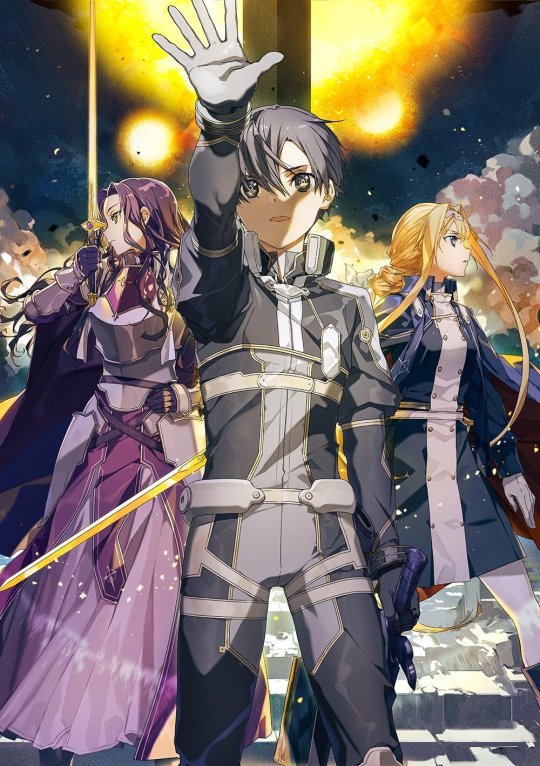
#oficial art#sao#sword art online#sao unital ring#unital ring#sword art online unital ring#kirito#kazuto kirigaya#kirigaya kazuto#kirito sao#sao kirito#alice sao#sao alicization#sao alice#sao anime#reki kawahara#alice zuberg#alice schuberg#alice synthesis thirty#ソードアート・オンライン#fanatio synthesis two#sao novel#light novel
63 notes
·
View notes
Text
bro why the fuck did the ending of the new sao abridged episode go that deep holy shit what the fuck
#i never got that far in the actual show so idk if it's like the show/light novel but god DAMN#sword art online#sword art online abridged#sao abridged
344 notes
·
View notes
Text

IT'S DONE
Free from my rendering prison <3
Really love how it came out! Though if there's one thing I'm not completely satisfied with, it's the snake tail, and I did make a mistake with the armor— but by the time I realized, I was already like 75% through rendering, so, rip lmao
44 notes
·
View notes
Text
Cheongmyeong: Sorry, what was I talking about?
Yunjong: You were apologizing.
Cheongmyeong: That doesn't sound like me
#source: sao abridged#<-Ep.7#return of the blossoming blade#rotbb#cheong myeong#yun jong#yunjong#incorrect quotes#incorrect rotbb quotes#cheongmyeong#the stress of not having read the novel vs. the laziness of not having the energy to read the novel fight#/light-hearted#queue#my quotes
70 notes
·
View notes
Photo


we've come so far, my dear look how we've grown ♡♡
#theyre the loves of my life look at them#kirisuna#kirito#asuna#sao#sword art online#mine*#edits#light novels#mine*edits
84 notes
·
View notes
Text

Autistic Kirito evidence 😌
#kirito sao#sao kirito#kirito kirigaya#jaimethinks#anime#sao light novel#light novel#sword art online
18 notes
·
View notes
Text

everywhere i go, i see it
7 notes
·
View notes
Text
2 notes
·
View notes
Text
Happy Pride Month! ❤️🧡💛💚💙💜🖤
SAO Pride Week starts on June 4th! We can't wait to see what you guys come up with!

#sword art onine ii#sword art online#sao#sword art online alicization#sword art online ii#sword art online war of underworld#sword art online alternative ggo#sao unital ring#sword art online light novels#sao progressive#saoprideweek2023
11 notes
·
View notes
Text
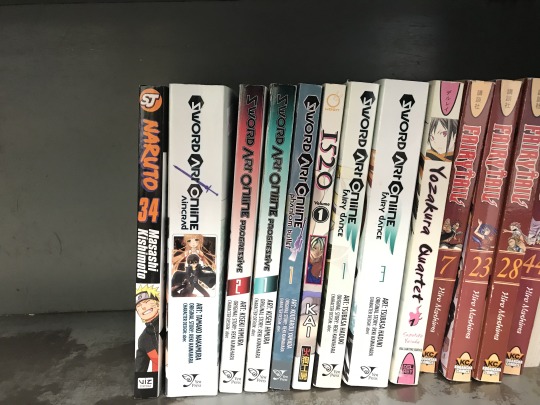
these lasted... like 28 SECONDS on the shelf...
🏃♂️
#used books#manga#thrift store#sword art online#sao#naruto#aincrad#comic books#light novel#thrifting#thrift books#fairytail manga
4 notes
·
View notes
Text
A Retrospective on Sword Art Online's Aincrad Arc

What you’re about to read was originally going to be a review of the first volume of the Sword Art Online series. Then after reading it along with the second volume, I realized that they were so interconnected that it only made sense to combine the two into one review. After that, I had a realization–most people reading this have probably already watched the SAO anime. Meaning that reading this would pretty much be redundant since it’s a pretty one-to-one adaptation. Even if you liked the anime, there’s no payoff in reading the light novels, since the anime has the superior version of the Aincrad arc. Needless to say, this review became more of a slightly below-surface-level view of Sword Art Online as a series, Reki Kawahara’s growth as a writer, and what you would be better off reading if you wanted to learn more about Aincrad. Please excuse the title, I couldn't think of anything better to name it.
Believe it or not, it’s been almost eleven years since Sword Art Online first aired. For those who don't remember, it was a huge deal when it aired. It was probably the biggest anime back in 2012. It was also the most panned, with many calling it overrated or saying it just plain sucked. While some of the criticisms were over the top, it was understandable why many didn’t like SAO–there were many better anime that aired that year that only got a fraction of attention it did. Many of SAO’s plot points, especially in the second half of the show, were rightfully slammed for being inconsistent about Asuna’s personality and the way it handled Kirito’s and Suguha’s relationship. After a while, it became ‘cool’ to hate on SAO. After all, it was a mediocre-at-best anime that became immensely popular despite said setbacks. I’ve always had a soft spot for SAO–for a series that wasn’t that good overall, it does maintain to keep being interesting, which at the very least is what you want. With that in mind, I decided to re-read the first and second volume to see how it holds up, years later after the hype.
For those who’ve already watched the first season of Sword Art Online, the first two volumes cover roughly the first half of it. It begins with Kirito, our protagonist, playing the game Sword Art Online, a Virtual Reality Massive Multiplayer Online Role-Playing Game (VRMMORPG). The game is played on a device called a Nerve Gear, a state-of-the-art VR headset that simulates all five senses. For Kirito and the ten thousand players that were able to log on and play SAO, they’ve just unwillingly signed up to be trapped in the game’s world (Aincrad). The game creator, Akihiko Kayaba, states that he’s holding them captive until they’re able to reach the 100th floor of the game’s map and that anyone who dies in the game also dies in real life.
I don’t think it’ll come as much of a surprise when I say that this book isn’t good. With all of the knowledge and lore I know about the Sword Art Online series, SAO volume 1 is alright–but on its own, it’s flimsy and hollow. After the big reveal that Kirito and everyone else in the game are trapped in there, there’s a two-year time skip, which in my opinion is a huge mistake. What the reader knows of SAO and Aincrad from this volume is almost at an elevator pitch level, assuming that this is their intro to the series. For now, we almost know nothing about the world around us–we just know about how powerful and cool Kirito is.
Most of our perspectives on this are warped because most of us already knew about Sword Art Online from the anime, which had a completely different pace from this. It’s why I’m including the second volume in this review as well. This volume skips most of the world-building and spends an extensive amount of time showing us what ends up being the final boss fight, along with Kirito and Asuna being together, although we as a reader don’t know that much about her or why she fell for Kirito in the first place. Funny thing is that the Aincrad Arc part of the anime takes parts from other entries in the light novel series–from Volume 8 (which is a collection of short stories, like Volume 2), Material Edition 1 (which I don’t even know is translated into English officially), and Progressive Volume 1 (written four years after the first volume was published, and is a ‘spin-off’ that expands on the Aincrad arc). To put in perspective how much this volume is lacking in detail, the anime adaptation only uses material from the first volume in episodes 1, 8-11, 13, and 14. That’s a whole lotta gaps! Compare that to the second half of the anime–the Fairy Dance Arc. It adapts from volumes three and four chronologically, and it shows in an obvious decline in plot quality. There are other reasons why that is, but that’s not relevant here.
I mentally tried to put myself as a reader that didn’t know anything about Sword Art Online before opening this book, and this was the interpretation I got: This volume leaves a lot to be desired. We know that Kirito is perhaps the most powerful person in the game. We know that Asuna is in love with him. We know that many have gotten used to life in Aincrad and have given up all hope of returning to the ‘real world’. But we don’t get to see them transition into that. All we get is the tail end, where life is already settled in. It zaps most of the fun out of it. It straight up didn’t make sense how THIS became popular enough to be animated in the first place–it is, until I did some more research on how this light novel came to be.
—
At the beginning of the afterword for Sword Art Online Volume 1, Reki Kawahara, the author writes “The volume of Sword Art Online you hold in your hands now was my first novel, written for the Dengeki Game Novel Prize in 2002.” He actually never submitted it, due to it being too long to enter, and instead published it online. The web version of Sword Art Online, which ran from 2002 to 2008, had popular support, but it wasn’t what got it published as a light novel. He won the Dengeki Novel Prize in 2008 with his story Accel World, allowing himself to finesse his way into also have SAO published as well. So basically, what we’re reading is the most juvenile writing that Mr. Kawahara had to offer. Due to it being not how he got his foot in the door, SAO was left on the back burner for Accel World. That being said, the web novel had LOADS of content, which made it more feasible for Kawahara to be able to publish both it and Accel World at the same time, even if the writing quality wasn’t up to Kawahara’s now-seasoned standards.
—
The second volume of Sword Art Online contains four short stories–stories that were sorely missing from the first volume. For the theoretical person in my head who has only read the first volume, and knows nothing else about the SAO universe, this volume gives some life to Aincrad and the society that formed in-game.
The first story, titled The Black Swordsman, starts on the 35th floor of Aincrad. Our hero runs into Silica, rescuing her from a mob of NPC monsters. Kirito and Silica go on a quest to revive Silica’s Tamed Monster, Pina.
This story introduces the concept of ‘Kirito, the older brother’–something that those who’ve seen the later half of the first season of Sword Art Online know full well about (many would claim that they know ‘too much’.) While Kirito admits that he’s helping her because she reminds him of his real-life sister, their relationship is nowhere near as weird. I have to say though, there were still some ‘sus’ moments. The one that comes to mind is Kirito saying “Level is just a number”. I cringed at least a little reading that, even if the context is way less insidious than expected.
Other than that, it was an alright story about the difficulties of being a young girl trapped inside Sword Art Online. While Kirito is also young (he’s only two years older than Silica), he’s had years of prior gaming experience before SAO, along with also being a beta tester. Silica, being only thirteen (and a girl), for better or for worse, has a constant stream of fellow players wanting to play with her. Her naivety gets her into trouble, being only saved by Jes-...I mean Kirito. This story also gives us a more in-depth look at the mid-level players of SAO. Silica, being ‘mid’ herself, doesn’t fight on the frontlines, and instead makes her living exploring already cleared dungeons in the lower levels of Aincrad. It’s a pretty good gig if you want some excitement in your life, but aren’t crazy (or strong) enough to be on the front lines. Probably beats subsisting on apples and being harassed by Army assholes in the Town of Beginnings.
The second story, titled Warmth of the Heart, features our hero with the blacksmith Lisbeth, who both go on a quest to the 55th floor to obtain a new mysterious metal–a metal so rare that it has not been dropped in-game yet.
This story was by far the worst. I feel bad for Lisbeth, because the entire reason for her existence is to be another girl to pine after Kirito. Yes, as you would expect, Kirito’s Law1 is in full force in this story–Lisbeth, swept by the enigma that is ‘Kirito’, falls for him in no time. Are there really no other honorable men in Aincrad other than Kirito? Well, of course, there’s Agil and Klein, but they’re adults. Lisbeth, while older than Kirito, is still a teenager. Not that age has ever stopped someone in Sword Art Online, but you’d think that there’s at least one other Japanese teenage boy stuck in the game that is as honorable, or even as nice, as Kirito. Guess not, considering that most male players in the game that aren’t Kirito and friends turn out to be huge sickos most of the time. Guess being trapped in a video game world with little hope of ever coming back gets to you after a while. Cabin fever did a number on more than a few men in Aincrad.
Anyways, back to Lisbeth–this story kinda rubs me the wrong way due to the way it establishes her character–someone who will only feel unrequited ‘love’. In scare quotes because it’s a ‘love’ that comes from being stuck with him for a day. Replace her with any other female blacksmith, and the story would’ve gone the same. Because he’s Kirito, and you’re supposed to want to be with him forever. It isn’t like Lisbeth is bland or anything. From what little we know about her, I like her. It’s just disappointing that her purpose (for now) is to be a side-piece of Kirito’s theoretical harem. She’ll never get what she wants because she’s not Asuna. Her fatalist interpretation of Kirito’s and Asuna’s relationship combined with her inability to move on traps her in Kirito’s ‘friendzone’, for a lack of a better term. Needless to say, this story doesn’t pass the Bechdel Test.
The Girl in the Morning Dew is the third story, featuring Kirito and Asuna shortly after they got married in-game. They come across a little girl named Yui, who collapses near the two while they’re venturing out to a remote part of the forest on the 22nd floor to look for a rumored ghost. Yui, not a ghost, nevertheless lacks a Color Cursor, something that every living object has in Sword Art Online. Kirito and Asuna, never one to not help someone in need, help Yui try to find where she came from.
Out of all of the chapters, this one is the best by far. The worldbuilding is a good thing to see. I mean, we gotta know about Aincrad first if we’re expected to care about it. A lot of the chapter is set in the Town of Beginnings, the starting town in Sword Art Online. It’s still the most populous town in all of Aincrad two years after the ‘game’ started. Most people who still live there are those who’re afraid to go outside the town’s walls. There’s also the Aincrad Liberation Force (known as the ALF, or simply as ‘The Army’), the largest guild in SAO with more than a thousand members, who make the starting town their base. It was nice to come back to where it all started, since Kirito stayed in here for all of one day the first time he was here.
This chapter delves into the conflict within the higher rungs of the Army and offers a very interesting insight into what happens when leadership breaks down. One faction of the ALF has turned to ‘taxing’ (extorting) the citizens of the Town of Beginnings–who’re probably the least well-off out of all of the people trapped in Sword Art Online, considering most of them haven’t even left the town. In typical SAO fashion, these ‘taxers’ are unnecessarily evil–they would take candy from a baby and laugh about it. Another victim of cabin fever. Caught between this is an orphanage run by a woman named Sasha, who houses twenty kids that’re stuck in SAO without a parent or guardian. There’s a lot about The Army that could be expanded, but since this is a series about Kirito, all we need to know is that they’re the closest thing Aincrad has to a form of government. Did you know that ‘The Army’ is actually a combination of two guilds, the ‘Aincrad Liberation Squad’, a front-line clearer guild, and ‘MMO Today’, a mutual aid organization that aimed to spread info about Sword Art Online and resources equally.
The final story, titled Red-Nosed Reindeer, is also the earliest story chronologically, taking place in December 2023, almost a year before Kirito and everyone else finally broke out of Aincrad. The story is also the only one where Kirito is the lone narrator.
This story hearkens back to an earlier time in Kirito’s Sword Art Online playthrough, when he briefly joined the ‘Moonlit Black Cats’, a small guild whose camaraderie was a welcoming surprise to the lone-wolf Kirito. Kirito hides his actual power level, pretending to be only two or three levels higher than the rest of the guild, while in actuality he’s Kirito, the all-mighty slayer of bosses and wooer of around half of the women he talks to. Nevertheless, things go horribly wrong one day when one of the members accidentally sets off a trap in a labyrinth, ending up killing four of the guild members and driving the remaining member to suicide. This memory still haunts Kirito months later, believing that he is the reason why the Moonlit Black Cats were killed. He’s especially guilty about Sachi, who Kirito was mentoring and teaching sword skills to.
While it’s woefully the shortest, Red-Nosed Reindeer is easily better than the first two stories. It’s the only insight that we get to see of the ‘early days’ of Sword Art Online, with all of the other stories in the book taking place in 2024, the year after. Our visit with the Moonlit Black Cats is only brief, getting only a little bit more than the cliff notes on them, but at least we got to meet them.
—
These four stories add some flair to the Sword Art Online universe, but still leave a lot to be desired. Aincrad is a vast and wonderful world, filled with ten thousand people’s stories–two volumes are better than one, but there’s still tons of meat on that bone. Mr. Kawahara agrees as well, regretting that the Aincrad storyline is only solved in one volume. To correct this, he started the Sword Art Online: Progressive series in 2012.
The Progressive series starts from the very beginning. I mean, the very beginning. The first volume only covers the first two floors. Kawahara, in his afterward for the first volume of Progressive states that “I wrote the story [Sword Art Online] as a submission for the Dengeki Novel Award, so I had to finish the story with the game being beaten, right in the very first installment.” Wow. So that explains why it was wrapped up so soon. The first volume quite literally was what he was going to submit in 2002. In a sense, it’s actually very cool, since what we’re reading is pretty much the first thing he wrote. One of the payoffs of reading the series is seeing the growth in Kawahara’s writing.
Continuing on, he also says that “Later on, I wrote a number of shorter prequel stories that filled in gaps (see Volumes 2 and 8), but they’re more like little episodes, and don’t focus on the meat and potatoes of the players advancing through the game.” Okay, so we did read Volume 2, but I’m not going to read Volume 8. This review is already long enough as it is. Moving on, I’m so glad that he gets that what supplements he wrote are substandard, especially for a great concept like Sword Art Online. They just don’t quite scratch the itch for people like me.
Moving backward, it’s pretty absurd to see an author so freely critique and criticize his most known and successful work. It was popular enough to have people begging him to write more when it was a web novel. It was somehow impressive enough to have it published as a light novel, which then had an anime adaptation that blew up in popularity, and since then has had several sequels and even a spin-off. It’s a staple ‘starting anime’ to this day, nearly a decade after it aired. It makes me respect him a lot to admit what he really thinks, and try to ‘rectify’ it in a sense. The Progressive series contains many ret-cons of the original novel. The biggest to me is when Asuna and Kirito meet–in the first volume, Asuna and Kirito are just kinda together forever already, and we’re supposed to care about it–but in Progressive, they meet a lot earlier. On the first floor. This change is for the good, because we get to see their relationship from the start. We get to see them slowly become lovers, rather than be dropped off via timewarp to literally a week before they get married. There are also characters from the original novel, like Agil and Kiabou, along with new ones.
So, is it worth it to read the Sword Art Online series? To be quite honest, I think it’s only worth reading the Progressive series, and that’s if you’re into the concept of Sword Art Online. I’ve only read the first volume of the Progressive series, and while it's miles better than the original series, it still wasn’t great. That’s only the first volume though. Kawahara has written a total of eight Progressive volumes–usually releasing them once a year. The funny part is that the SAO light novel series didn’t have an original arc until 2017. The guy got 18 volumes of content from what was basically something he wrote for fun. I know light novels aren’t the longest things, but that’s a lot of words! So basically, this arc up to the Alicization arc was already written by 2008, and Kawahara was only able to write new arcs when the light novel caught up to where his web novel was when the series was originally published. That’s quite a mind boggle. It also pieces together why it became big enough in Japan to warrant an anime adaptation. Since there was already a web novel, Japanese readers had the opportunity to read past where the light novel is, if they didn’t ready before reading SAO. The context it was released makes it suffer from poor-quality writing and bad pacing, but those gaps could be filled by the web novels, which were only ever released in Japanese. The light novels began being translated into English in 2014, two years after the anime aired. Most of those who bought the light novel had already watched the anime. This means that my theoretical person whose first experience with SAO is with these light novels was likely a larger minority than I originally thought. Sword Art Online really is a weird series!
It might be worth a read of the main series–only after you’ve read all of the Progressive series that is. I mean, it’s up to you. The anime series has adapted the light novels up to the end of the Alicization Arc. You could either watch it or read it. That is, if you wanted to in the first place, which I highly doubt.
‘Kirito’s Law’ is a slight deviation from the more well-known ‘007’s Law’–basically, any woman who interacts with Kirito for more than four hours has a fifty-fifty chance of falling in love with him. Unlike ‘007’s Law’, these women pass away ten times less often. These two terms were made up by me at the time of writing this.
17 notes
·
View notes
Text

When delivery bends the book...
#sword art online#sao#sao unital ring#unital ring#sword art online light novels#asuna#asuna yuuki#excuse my copy of pragmatics of word order flexibility#im doing linguistics things always
3 notes
·
View notes
Text
Chapter 5 of Unital Ring IV Volume 25 confused me who was talking but I did figure out it's going from Kazuto, Asuna and Kazuto POV again (sorry, I took it while I was on my bed)



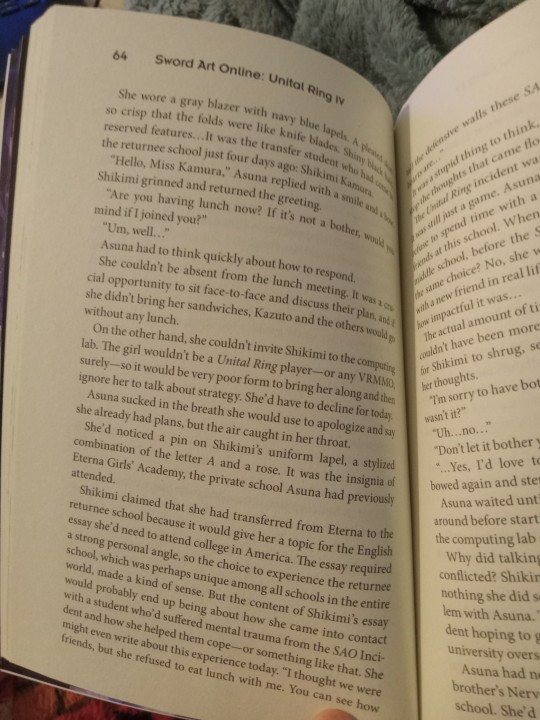
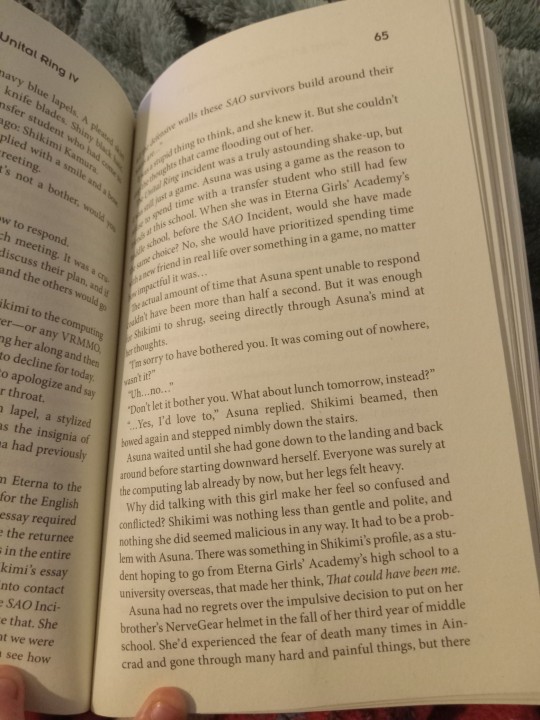
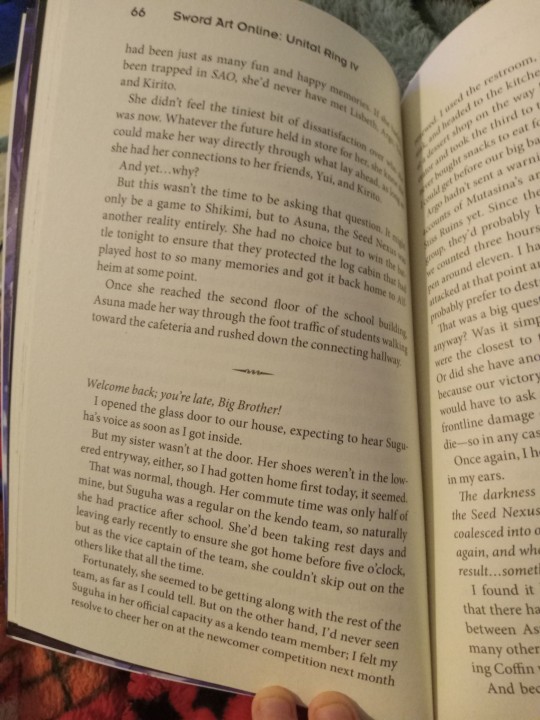
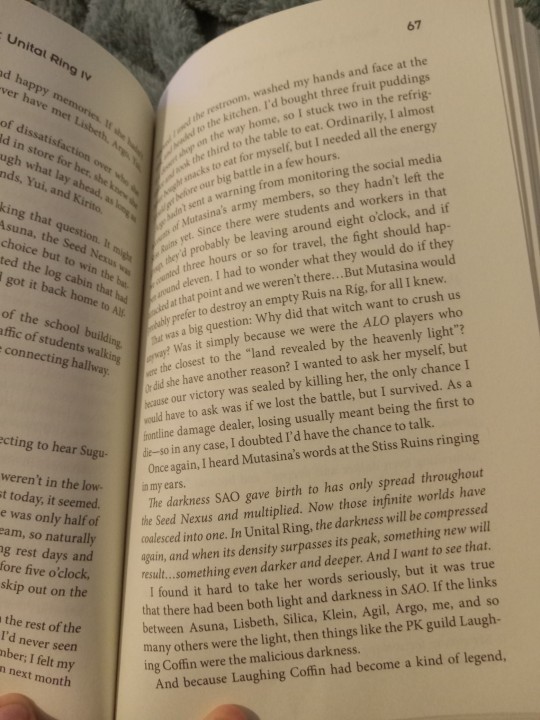
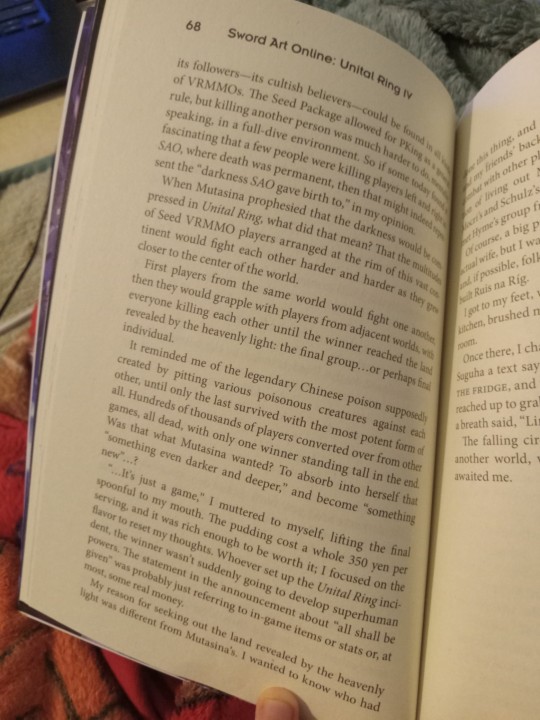

#sword art online#sao alicization#kirito#kirigaya kazuto#yuuki asuna#light novel#unital ring#spoiler alert
7 notes
·
View notes
Text
The Ever-Changing Story (Part 1): About Sword Art Online's (lack of) continuity
I'm a big fan of Sword Art Online (SAO), and I came to the series through watching the first three seasons on Netflix. It was on a whim, basically, but I became hooked, and in the last 2 1/2 months I have watched four seasons, one movie, read 28 books, and even several mangas - all works (or based on works) of Reki Kawahara, the original author.
Let's start with a simplified synopsis of the story, and from hereon there will be spoilers.
The plot of the original SAO story is set in an MMORPG world called Aincrad, composed of 100 floors. After the first 10,000 players have logged in, they are told that they can't log out anymore and that the game will kill them if they die in game or somebody removes the VR gear that completely immerses them in this world. Their only choice is to beat all 100 floors, after which the survivors will be automatically logged out.
The story then skips forward to floor 74, there's a fast-paced romance between the protagonist and a girl, and after some dramatic reveals after a battle against the boss of floor 75, our hero Kirito unmasks one of the most prominent players in the game to be the genius/villain that trapped them there to begin with, there's a final showdown with several tear-jerking twists, and then the game is beaten. All survivors get logged out.
Seems like I must've missed something? If you've watched the anime, I seem to have left big chunks out, right? But that's the "original story" as published as a light novel ("Sword Art Online 1 - Aincrad"). I put "original" in quotes because the true "original story" was first published on the web, then edited and lightly rewritten before being published as an actual book.
And it has changed ever since.
Retcons on top of retcons
From here on it gets weird. Even in the anime series, Aincrad gets a comparatively short treatment, 14 episodes of the 25 episodes comprising the first season. This is because the story of beating Aincrad is dispersed over many books by now, and most of it was written as stories inserted into an existing but also vague and largely empty timeline, typically involving some form of retconning.
The story I provided the synopsis for was SAO volume 1. Volume 2 added side stories, introducing several characters not seen before. Further side stories were added in volumes 8 and 22, and Kawahara started a series describing beating Aincrad floor by floor, called Sword Art Online Progressive (SAOP), which now comprises its own 8 volumes. In addition there are various side stories, published online, in magazines, as bonus material for example for other media including manga and anime, plus computer games. (But as far as I can tell you can largely ignore the computer games - they willy-nilly change canon anyway to attract as many players as possible.)
In other words, if you'd watched the anime, you would have seen, roughly in this order:
SAO 1 - Aincrad
SAOP 1 - Aria of the Starless Night
SAO 2 - Aincrad
SAO 8 - Early and Late
SAO 2 - Aincrad
SAO 1 - Aincrad
SAO 2 - Aincrad
SAO 1 - Aincrad
So, the anime is basically woven from four different books, one written in response to flesh out the anime a bit (SAOP 1). If you liked Yui, Liz, or Silica, they were all late additions.
The retcons in the anime are sometimes nice little details. For example, when Kirito publicly displays his Dual Wielding unique skill, he hides out in Agil's shop. In the anime, Liz walks by and teases him about letting out what was their secret. This actually happened in the second volume, while the scene actually stems from volume 1, so Liz did not exist to feature in that scene. But she fits like a glove here.
Retro-continuity
So, as a viewer of the anime, or using the anime as timeline, you come to a continuous, coherent story. This is not true for the novels, though, as Kawahara readily admitted whenever he published a new one. Each volume contains apologies for the inconsistencies he introduced when shoving new stories in.
His approach, however, is very pragmatic. Whatever he wrote last is basically true. This can be minor, like his admission from Volume 8 regarding his short-story "The Safe Haven Incident". So, for example in an earlier volume he wrote that Kirito had never taken Asuna to a restaurant run by an NPC before. This is exactly what Kirito does in this story, which in turn is set - but only within the world chronology! - before the story it modifies.
By the way, that's exactly the same detail Kawahara then contradicts again in SAOP, but SAOP is special...
You see, whenever somebody asks (on social media) if SAOP is a rewrite or reboot, there's a lively discussion where people go to great lengths to say that's it is not. I wholeheartedly disagree - SAOP is a huge reboot camouflaged behind lip service to existing continuity. And it heavily depends on which SAO or SAOP book you've read or media you've watched last as to what your conclusion might be.
And mine is - yes, the story has been rebooted. We might never see absolute proof for this as the story will likely never be finished. It took eight volumes to describe the beating of seven floors so far, casting doubt on the doability (or desirability) of doing this for the total of 75 floors mentioned in the original outline. But the longer the story progresses, the more heavily it deviates not only from the original plot points, but it also starts to rewrite characters - at least regarding their motivations and traits. And then they no longer fit their roles assigned to them in plot points alluded to in earlier novels.
A concrete example of how retro-continuity works
SAO Volume 22 contains the short story "The Day Before" - an account of what happened shortly before Kirito and Asuna got married in-game. It barely carries on for a page before it introduces us to what Kirito knew of Asuna or had experienced so far:
He had her as "impromptu party member".
She joined the Knights of Blood guild and took part in "our boss raids".
She "helped investigate mysterious safe-zone murders"
She "cooked S-ranked ingredients into meals for me".
The way he describes these events, including the connecting words, imply they happened in this order. This implies they were taken from the following books:
SAO Progressive Volume 1 onward.
Not actually depicted in any books, but mentioned since SAO volume 1. (When Asuna appears in SAO Vol. 1 she's the sub-commander of the KoB and takes part in the two boss encounters featured in the novel.)
SAO Vol. 8.
And back to SAO Vol. 1.
It is heavily implied that the term "impromptu party member" refers to SAOP Vol. 1 because she joined KoB after. (Not to be confused with them partying up in the middle stretch of SAO Vol. 1.)
In other words, within this story, published as Vol. 22 of the main line, events happening in some early SAO Progressive novels are confirmed as canon that overrides earlier canon. Whenever this volume or side stories introduce additional facts or change them, they are treated as if they had always been true. (You could say the new "normal" is whatever Kawahara wrote most recently, no matter if the information stems from the SAO or the SAOP series.)
This becomes especially noticeable if you actually read the light novels last, in a reverse order, after watching the anime, etc. There wasn't a grand master plan later novels slot into. Each new one is crammed in, and as that is done, it displaces some of the original story.
More things are then casually introduced: "Field bosses," a concept only present in SAOP. Further along, it is established that "we" (Asuna and Kiroto? The frontrunners?) typically ignore side quests - which is funny as this will be later contradicted again and overridden by further SAOP installments to follow, and quite drastically so. (In SAOP it becomes imperative to do quests to get potential info about floor bosses and how to beat them. It probably helped filling these books and making them the entertaining reads they are.)
We also get to meet Argo, who is characterized pretty much the same as in SAOP throughout. (And Argo existed only as a name drop before SAOP was written.) So Argo didn't exist until SAO 2, gets fleshed out as character much later in the SAOP novels, and she "returned" to the mainline novels volume 21 and forward. In 21 she only appears in the final scene, and in 22 we get side stories supposedly telling events from Aincrad - featuring Argo, probably so that main series readers can get used to her, she technically being an addition to the cast of that series.
We're also told about the great tragedy that befell Kibaou and the Aincrad Liberation Squad - which is greatly expanded on (in SAO 1 the "Aincrad Liberation Force" simply "got burned" on the 25th floor. In the SAO mainline novels before that Kibaou was only mentioned once, as a villain. Now he's made sympathetic. This is a major change, but if you've read SAOP you'll find that Kibaou is a character you can empathize with more and more the longer that series progressed. This change will be discussed further in part 2 of this article.
Growing backwards in time
Additions from volumes 2 onward fall into two categories: Those taking place before the main events of floor 74 forward in the first novel. And those taking place within the period between Kirito proposing to Asuna and their return to the frontline to fight the boss of floor 75.
In the first category we find:
The Black Swordsman (SAO 2)
Warmth of the Heart (SAO 2)
Red-Nosed Reindeer (SAO 2)
The Safe Haven Incident (SAO 8)
The Day of Beginning (SAO 8)
Day of Beginnings (in a tweet)
Hopeful Chant (bonus story as backstory for "Ordinal Scale" movie)
All "Sword Art Online Progressive" novels (SAOP 1-8)
In the second category we find:
The Girl in the Morning Dew (SAO 2)
Sugary Days (online side stories)
The Day Before (SAO 22)
Now that I went to the trouble of listing also "Hopeful Chant", it's another wonderful example of a retcon. Here Asuna meets Kirito during his darkest days in Aincrad - and suppresses her heart-felt wish to partner up with him again. (Which of course can only be an again at this point in time if everything within the SAOP series is canon.)
The original SAO 1 was the story of a girl who chased a boy she'd fallen in love with, until he wizens up and they become a couple. This point was reiterated in SAO 2 where Asuna talks to Lisbeth about her supposedly unrequited love for Kirito (without naming in). By the time "Hopeful Chant" was written, however, it has become the story of a girl that had a deeply trusting partnership with a boy that somehow (we don't know exactly how nor has this part been written) got torn apart and the mysterious magic happens and this somehow leads us back to the events from floor 74 forward. More recently written things invalidate things written earlier in SAO.
So it would be wrong to say SAO "grows backwards in time." SAO grows on top of SAO. It's like one of these ancient cities where you dig out layer that rests on top of another layer, or like Terry Pratchett's Ankh-Morpork which is described on having been built on, well, Ankh-Morpork.
If these were just "facts" or "factoids" this might not be so important. In fact, most people ignore this altogether and go with the assumed continuity, or with a continuity that exists in their own heads after having consumed the various SAO media in whatever order suited them (and ignoring any contradictions as long as they are not too glaring). In fact, if you read SAO novels in their publishing order, you might not notice it so much. Each story in itself seems consistent, and you tend to forget the exact details of former stories.
And so the ground shifts beneath you and you don't notice that you're now in a different story than you started with. This becomes apparent if we less focus on the supposed outlines (the top-down aspects of the story, its plot point framework) and focus more on the characters, their traits, arcs, values, etc, and what stories derive from them (the bottom-up aspects of the story).
Which we'll do in the second part of this article, to be posted soon.
5 notes
·
View notes
Text
something witty's abridged parody series adapted sugu more faithfully from the light novels than a-1's official anime adaptation did
#sao abridged#leafa#i'm willing to die on this hill btw the door scene is fucking perfection and a-1 screwed it up completely#a-1 absolutely ruined suguha. light novel sugu is s so different to the anime.
12 notes
·
View notes
Text
Why did Eugeo have to die in the light novel and anime, it's not fair he should have lived. Plus if he lived Eugeo could have helped Alice out on Kirito vegetative state and he could have gone to the real world and met Kirito's friends.
#eugeo#sao eugeo#sword art online alicization#sword art online#not fair eugeo died#not fair Eugeo died in the anime and light novel
4 notes
·
View notes